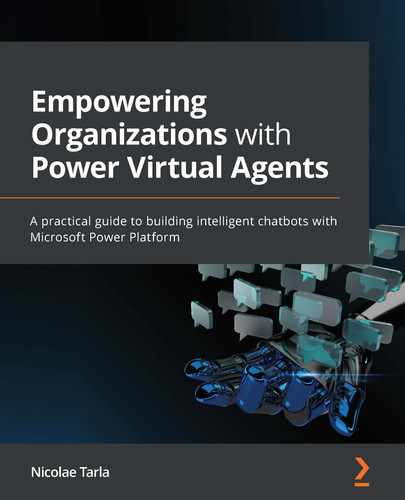Unleash the capabilities of Power Virtual Agents to provide actionable insights to your customers and employees using automated chatbot solutions Power Virtual Agents is a set of technologies released under the Power Platform umbrella by Microsoft. It allows non-developers to create solutions to automate customer interactions and provide services using a conversational interface, thus relieving the pressure on front-line staff providing this kind of support. Empowering Organizations with Power Virtual Agents is a guide to building chatbots that can be deployed to handle front desk services without having to write code. The book takes a scenario-based approach to implementing bot services and automation to serve employees in the organization and external customers. You will uncover the features available in Power Virtual Agents for creating bots that can be integrated into an organization's public site as well as specific web pages. Next, you will understand how to build bots and integrate them within the Teams environment for internal users. As you progress, you will explore complete examples for implementing automated agents (bots) that can be deployed on sites for interacting with external customers. By the end of this Power Virtual Agents chatbot book, you will have implemented several scenarios to serve external client requests for information, created scenarios to help internal users retrieve relevant information, and processed these in an automated conversational manner. This book is for organization representatives looking to automate processes, relieve the first-contact workload of their front-line agents, and provide actionable results to employees and customers. Business professionals, citizen developers, and functional consultants will also find this book helpful. Familiarity with the Modern Workplace and the Dynamics 365 family of products will be useful. Beginner-level knowledge of Power Platform and its main modules will assist with understanding the concepts covered in the book more effectively.Key Features
Book Description
What you will learn
Who this book is for
Table of Contents
- Empowering Organizations with Power Virtual Agents
- Contributors
- About the author
- About the reviewer
- Preface
- Section 1: An Introduction to Power Virtual Agents
- Chapter 1: Introducing Power Virtual Agents
- Chapter 2: Licensing for Power Virtual Agents
- Introducing the licensing and pricing structure
- Understanding Power Virtual Agents and the Power Platform
- Getting access to Power Platform
- Power Platform licensing expanded
- Imposed limits on Power Platform
- Managing Power Platform licensing
- Understanding Power Virtual Agents in Microsoft 365
- Dataverse database capacity
- Dataverse file capacity
- Dataverse log capacity
- Licensing considerations
- The scenario
- Estimating usage
- Summary
- Chapter 3: Building Your First Power Virtual Agent Chatbot
- Section 2: Leveraging Power Virtual Agents on Your Website
- Chapter 4: Creating a Power Virtual Agent for Your Website
- Introducing a PVA for your website
- The Greeting Topic
- The Thank you Topic
- The Start over Topic
- The Goodbye Topic
- The Escalate Topic
- The End of Conversation Topic
- The Confirmed Success Topic
- The Confirmed Failure Topic
- Description of the business scenario
- Extending our basic PVA
- A look at decision logic
- Guiding the conversation
- Summary
- Chapter 5: Integrating a Power Virtual Agent into Your Website
- Chapter 6: Handling Authentication and Personalization
- Section 3: Leveraging Power Virtual Agents in Teams
- Chapter 7: Building a Power Virtual Agents Application for Teams
- Chapter 8: Integrating the Power Virtual Agent into Teams
- Chapter 9: Serving Information from Various Sources
- Section 4: Best Practices for Power Virtual Agents
- Chapter 10: Power Virtual Agents Governance
- Chapter 11: Power Virtual Agents Best Practices
- Design and build best practices
- Putting together the right team
- Providing measurable value
- Power Virtual Agents life cycle
- Understanding your licensing constraints
- Handing off to support agents
- Defining the success factors to monitor for
- Alignment with organization goals
- Managing your starter template
- Understanding the environments
- Implementing best practices
- Starting small and building up
- Creation of the first bot versus additional bots
- Topics structured around one unit of conversation
- Writing topic trigger phrases
- Setting the expectations
- Asking questions
- Handling long-running processes
- Managing best practices
- Reviewing analytics for continuous improvements
- Deleting bots
- Known issues and working around them
- Summary
- Chapter 12: Power Virtual Agents Administration
- Other Books You May Enjoy
